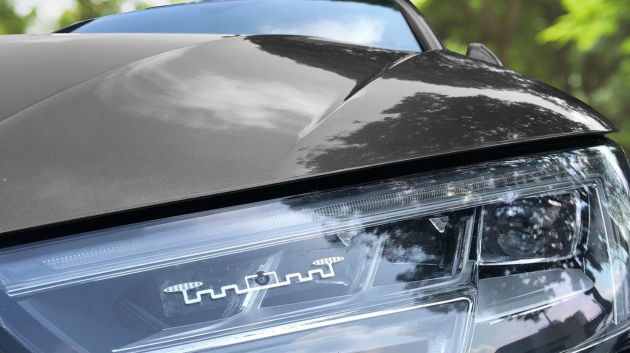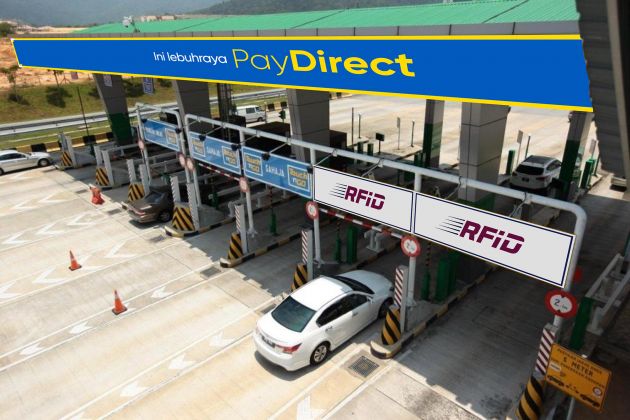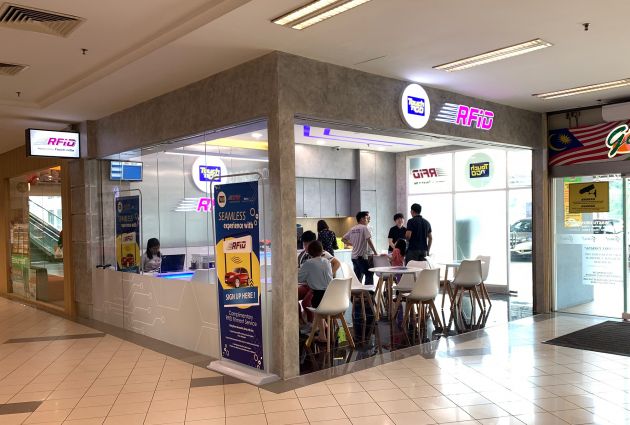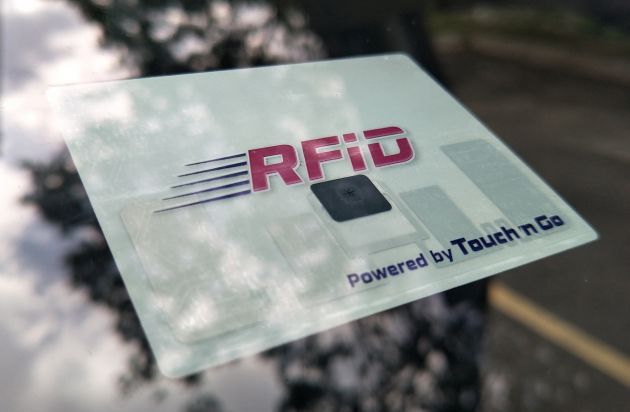Last September, Touch n Go (TnG) began the utilisation of radio-frequency identification (RFID) for electronic toll collection with the start of a public pilot programme, which has since seen a sizeable community of over 200,000 pilot testers across the Klang Valley, Johor and Penang being enabled during the initial pilot stage deployment.
Now that installation has been opened to walk-in customers supported by over 40 TnG Fitment Centers, more motorists are signing up for the system, which utilises a sticker-based passive tag attached to the exterior of an individual vehicle (in most cases, placed on the headlight).
When attached, the tag – which contains electronically-stored information stored on a micro-sized chip and is uniquely identified to each vehicle – performs the same electronic payment for toll collection like physical TnG cards and the Smart Tag reader, but in more convenient hands-free form, made seamless by the TnG eWallet.
This is because, unlike a barcode being scanned by a reader at a retail shop, the RFID tag does not need to be within the line of sight of the reader as it operates on radio waves. The RFID tag will transmit the necessary info when accessed by the RFID reader, providing the information exchange in encoded fashion.
Under the current TnG RFID pilot for toll, when passing through the RFID lane, the reader will emit a signal to the RFID tag via an antenna. The tag then provides relevant information such as available balance and the toll fare is then deducted from a user’s electronic wallet (like the TnG eWallet) that is linked to the RFID tag.
Why RFID?
Well, the idea isn’t new. The tech has been in use in many industries such as production, where it can be used to manage goods and inventory, as well as data identification in travel documents such as passports and airline baggage.
In fact, most of us utilise RFID on a daily basis without realising it – aside from credit cards which you can wave to pay for purchases, the tech can be found in office access RFID cards, and season parking or housing entry passcards for vehicles are also commonly RFID-based.
Its large-scale adoption across a multitude of platform spectrums is no surprise – RFID offers good, stable signaling aspects with fast response times, and it is relatively cheap to implement, with regards to tags. Scanning range can reach long distances, though it is dependent on the system and necessity.
Active or passive RFID?
Primarily, there are two types of RFID systems, active and passive. In an active system, the tag operation is battery-assisted, and having power means that the tag can relay the signal back actively to a transmitting reader, effectively amplifying the return signal, much like how SmartTag works, although that’s an RFID-to-infrared reading system.
While an active tag enables a signal to be broadcast over longer distances than with a passive tag and with greater efficiency, the need for power means that a battery-operated RFID active system would incur a higher cost from the tag, and such a system would be subject to the same operational issues prevalent with the current SmartTag, such as battery failure, which renders the unit inoperable and the tag unreadable by the interrogator.
As such, passive RFID tags like the one employed in the TnG application are not powered, and work with an active reader on the toll gate, which sends an electromagnetic signal and reads the info off the RFID tag.
While the passive tags may not be as powerful as the active tags, the tags that are used for tolling are ETC grade sticker tags, which has the ability to be detected at high speed when used in a multi-lane free flow highway scenario.
RFID, a solution to reduce congestion at toll plazas?
In this age of advanced technology, our toll booths are in desperate need of an upgrade and this method hopes to do the same. The implementation of RFID tagged to the eWallet as another means for toll payment will enable motorists to make payment without stopping at toll plazas, and this has the potential to reduce traffic congestion and commuting time considerably.
Passive tags are available in three frequency types, low (LF), high (HF) and ultra-high (UHF), but the first two are for near-field communication purposes and don’t concern automotive applications, being used in areas such as animal identification and premise access control (LF) and smart/credit cards (HF). The passive system as seen in the TnG system is a UHF type.
As for speed, an active system allows for higher operating speeds, but again, given how our tolls are set up, there’s no need to increase that until we get to a system utilising Multi-Lane Free Flow (MLFF) gantries.
In general, a UHF tag – which operates at a frequency of between 919 to 923 MHz, depending on the particular system – features an antenna around 16 cm wide, made out of a metallic compound (aluminium, copper etc) deposited on the substrate, as exemplified by the TnG RFID passive tag used here.
The primary advantage of such UHF tags is that they are cheap to produce and easy to replace, and there’s never ever any need for a battery replacement. Cost-wise, an active RFID system would be around five times more than a passive one, and that’s something that consumers might not be willing to fork out for.
On the whole, the use of RFID in toll collection promises an improvement in on-the-road experience for road users. In addition to being hassle free, and not just from a contactless point of view, the linking of an eWallet makes it easier for motorists to monitor payments and manage reloads.
Going beyond tolls – parking a viable possibility for RFID
Beyond toll collection, other applications for RFID in the near future can very easily include parking payment. Here, the TnG RFID tag can be utilised as a digital key, in which a parking lot reader detects and reads the RFID chip and allows entry and exit from the premises, deducting the parking fee from the eWallet.
The most notable benefit of RFID in parking management is that vehicles can be permitted to enter or exit the parking facility without human intervention, enabling cashless transactions and eliminating the need for physical parking tickets. This can be achieved by a simple extension of the existing Touch n Go RFID system, which has been put to test in a “live” use case scenario over the last eight months across toll ways.
It would be interesting to see if TnG can roll out this service in the near future by working with relevant stakeholders and local authorities.
Retail play – too far-fetched or a distant reality?
There is also the possibility of RFID being used as a means of payment for retail transactions, with petrol station and drive-through retail payments being made via the UHF tag affixed to the car. Can you imagine rolling down a fast food/coffee drive-trough, and making payment through your (auto-reloaded) eWallet, seamlessly via your vehicle’s RFID chip?
Further down the road and moving away from dependability on the TnG card, off-site retail could be possible with the use of wider near-field communication (NFC) adoption in mobile phones, with payment again accomplished through the eWallet.
Can TnG and the authorities reap the benefits of RFID further for connected motorists?
Across different industries, new innovative ways to use these RFID tags are being thought up every day. As it progresses, the unique identification provided by an RFID tag also has potential to be used as a dedicated vehicle identifier, with accessible information for dealings with official matters related to the vehicle, for example, vehicle inspection as well as road tax and insurance renewal.
The recent move to implement RFID to modernise Malaysian highways by TnG and the authorities holds good potential to offer greater convenience to the motorist/consumer. The contactless aspect of RFID will make journeys more seamless, as drivers will no longer be hindered by the process of toll payments in the future.
As we journey towards more solutions to enable a cashless experience, Touch n Go should seriously consider grouping mobility payments beyond toll collection via RFID tagged to its electronic wallet – making it a single stop solution for all payments linked to a vehicle.
Find out more about RFID here.
Looking to sell your car? Sell it with Carro.










rfid is already out of date. the industry is moving into gos based solutions that’s much more connected and flexible.
Rfid is an old tech that SG ERP is going to replace with GPS based.
Why still need physical toll? more cost and people to maintain ? still slow as it is still going to toll booth.
Changing toll location and adjusting charge rate is a pain.
So you prefer they charge you toll without you knowing it?
I Have install RFID on my car & wife’s car. The reception depends on location. RFID in NEP highway doesn’t work at all. Smart tunnel & Maju Expressway RFID works fine but you have to drive slow like 20km/h some times 10km/h most of the time late detection. I still prefer smart tac.
The objective of better system than SMART TAG is to solve “massive traffic jam bottleneck issues at toll” to maximize vehicle cycle time achieved “zero congestion” at toll. If vehicle needed to be slow down from constant 110kmh just for RFID as same SMART TAG, that consider a FAIL PROJECT to address objective and money wasted for nothing, just Stup…
Still have to line up at the tol.
Still have to face the bottleneck jam exiting the tol.
Singapore have eliminated this problem more then 10 years ago, pls catch up.
Totally agree. Thus rfid is of technology. Singapore’s invehicle unit is more efficient and versatile. If your card is low in funds, you can swap and use a different card. I fear the cost of top up of funds will attract a high service fee. 20 cents or no service charge for Singapore. The top up for TnG is 50sen and RM1.00 for top up for the parking app in Melaka, which is too damn high. Buying old technology n robbing the users.
Currently ….. 99.5% of ALL drivers HAVE a HandPhone. Once 5G become REALITY in 3 Years, TAG ARE NO LONGER required. 5G , With 1 ms responce/reaction time ….. ALL CARS can “SPEED THRU” any Toll !! FASTER than RFID !! Provided the TOLL operators “RICE BOWL” are NOT distrubted ! CHINA will be DOING IT ( Prediction ).
Touch n Go should seriously consider grouping mobility payments beyond toll collection via RFID tagged to its electronic wallet – for all payments.
Exactly like in UK Oyster and SG EZlink.
Malaysia’s RFID system is still way too young in its infant stage. It’s neither fast nor long distance enough despite having the need to stick on the outside of the windscreen. Having run numeral tests, I still need to slow the car down a significant amount and sometimes even too close to the boom bar in order to get a read.
Furthermore, with this “passive” style, sticker stuck outside of my car- it interrupts my housing area RFID reader.
It’s a poorly executed plan when it could’ve been done a lot better. With the privilege of a smoother transition at tolls, users should be expected to pay a higher price… There are no true winners by going the cheaper route.
As of now, the SmartTag will still be more reliable and convenient as opposed to the RFID. Of course at the user’s discretion and responsibility.
Don’t talk about RFID. Talk about car parks still charging a premium to park using Touch and Go
Our Government so lembap to put a stop to this
My area those installed rfid, security gate won’t open as it detect both. All the promo but do share how convenient if one tag in and when tag out unablento read cud be due to stone chip unreadable during the journy.how convenient is it to user to rectified when one is stuck at the toll booth.
The toll gate congestion are caused by drivers who would top up for just enough use. Study the top up values. I believe the RM 10.00 will be the most. Take away the top up lanes and see a miracle.
As I mentioned many times. The congestion is not merely caused by the slow toll booth flow. Many high traffic flow highways are caused by the bottleneck after the toll. Where 10 lanes of booths join into 2-3 lanes in a short distance. See LDP, majority of busy Plus highway exit during like Sungai Buloh exit, Subang exit into NKVE, etc etc.
“Can you imagine rolling down a fast food/coffee drive-trough, and making payment through your (auto-reloaded) eWallet, seamlessly via your vehicle’s RFID chip?”
This is scary bit… Unless u can tap approve in ur phone somehow. Else anybody can charge u for nothing.
On toll gantry usage… We can only truly eliminate toll lanes if they can simulate situation where u won’t need it at all under all circumstances. For example, under current iteration, if one don’t yet have rfid tag for the car, he/she needs to drive that car to a fitment centre – a deadlock situation for ppl in Puchong (where everywhere u go u bound to go thru a toll) or places with similar problem
I was told the RFID has the feature to link our TnG card to the eWallet. When the eWallet balance is low, it will debit the TnG card automatically.
But when I passed through the RFID lane that day with insufficient balance, it didn’t debit from my TnG card (which has sufficient balance).
Appreciate TnG to rectify this problem.
I feel that why this RFID thingy came about is because they want us to have an e-Wallet account with them n deposit our money. Why should we? They are monopolizing the industry and yet they still want our money?? They and their shareholder PLUS should improve the services in the toll lanes and congestions. RFID technology is nothing to rave about.
Nat tukar RFID chip, dekat mana saya boleh dapat? saya duduk cheras.thx
All malaysia can use
People must be given more options not by forcing them to use RFID. Currently i am using Zing, smarttac and TnGo and i find it okay. By changing to RFID is not going to help much. Forcing people to pay RM35.00 for installation of RFID is expensive and what is the guarantee about the wear and tear of the RFID sticker installed on the cars. If the RFID sticker is damaged or not readable and the poor people have to fork out once again to installed a new RFID sticker. The authority should come up with a better quality sticker to be installed inside the windscreen and not outside the car where through vandalism or by sending for a car wash can cause damage to the so called RFID sticker.